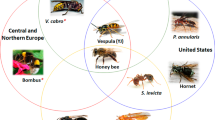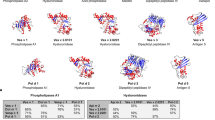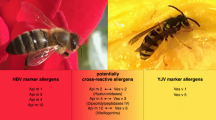Abstract
Background: Advanced component-resolved diagnostics (CRD) in Hymenoptera venom allergy (HVA) has improved the precise description of individual sensitization profiles. However, diagnostic gaps, peptide-based cross-reactivity, early identification of severe reactors and diagnosis of patients with a clear history of sting reactions but negative specific IgE and skin tests, remain challenging.
Methods: Systematic literature search in PubMed and critical analysis of recently published studies on insect venom allergy diagnostics.
Results and discussion: CRD has increased the sensitivity of IgE testing and improved the discrimination of primary sensitization from irrelevant cross-reactivity, ultimately providing a better rationale for therapeutic decisions. Despite these major advances, there is still room for improvement in routine HVA diagnostics. Peptide based cross-reactivity among homologous allergens from Vespinae and Polistinae venoms as well as still existing diagnostic gaps are particularly challenging. No marker allergens are currently available to differentiate Vespula and Polistes sensitizations. Several strategies including clinical setting of basophil activation test (BAT) for routine diagnostics, venomic analysis for the identification of novel allergens and characterization of the molecular basis of cross-reactivity could be used to address major limitations and unresolved issues in molecular diagnostics of HVA.




Similar content being viewed by others
References
Demain JG, Minaei AA, Tracy JM. Anaphylaxis and insect allergy. Curr Opin Allergy Clin Immunol 2010;10:318-22
Worm M, Eckermann O, Dolle S, Aberer W, Beyer K, Hawranek T, et al. Triggers and treatment of anaphylaxis: an analysis of 4,000 cases from Germany, Austria and Switzerland. Dtsch Arztebl Int 2014;111:367-75
Bilò MB. Anaphylaxis caused by hymenoptera stings: from epidemiology to treatment. Allergy 2011;66:35-7
Bilò BM, Bonifazi F. Epidemiology of insect-venom anaphylaxis. Curr Opin Allergy Clin Immunol 2008;8: 330-7
Golden DBK, Demain J, Freeman T, Graft D, Tankersley M, Tracy J, et al. Stinging insect hypersensitivity: a practice parameter update 2016. Ann Allergy Asthma Immunol 2017;118:28-54
Sole D, Ivancevich JC, Borges MS, Coelho MA, Rosario NA, Ardusso LRF, et al. Anaphylaxis in latin America: a report of the online latin American survey on anaphylaxis (OLASA). Clinics 2011;66:943-7
Sturm GJ, Varga EM, Roberts G, Mosbech H, Bilò MB, Akdis CA, et al. EAACI guidelines on allergen immunotherapy: hymenoptera venom allergy. Allergy 2018;73:744-64
BilòMB, OllertM, Blank S. The role of component-resolved diagnosisin hymenoptera venom allergy. Curr Opin Allergy Clin Immunol 2019;19:614-22
GuimarãesM. Death Swarm. Pesquisa FAPESP, 2009. Available online: http://revistapesquisa.fapesp.br/en/2008/ 11/01/death-swarm-2/ (accessedon 01 September 2019)
Jakob T, Müller U, Helbling A, Spillner E. Component resolved diagnostics for hymenoptera venom allergy. Curr Opin Allergy Clin Immunol 2017;17:363-72
Spillner E, Blank S, Jakob T. Hymenoptera allergens: from venom to "venome. Front Immunol 2014;5:1-7
Blank S, Seismann H, Bockisch B, Braren I, Cifuentes L, McIntyre M, et al. Identification, recombinant expression, and characterization of the 100 kDa high molecular weight hymenoptera venom allergens Api m 5 and Ves v 3. J Immunol 2010;184:5403-13
Jakob T, Blank S, Spillner E. Benefits and limitations of recombinant allergensin diagnostics of insect venom allergy. Molecular allergy diagnostics: innovation for a better patient management. 2017. pp. 341-62
Van Vaerenbergh M, Debyser G, Devreese B, de Graaf DC. Exploring the hidden honeybee (Apis mellifera) venom proteome by integrating a combinatorial peptide ligand library approachwith FTMS. J Proteomics 2014;99:169-78
Blank S, Etzold S, Darsow U, Schiener M, Eberlein B, Russkamp D, et al. Component-resolved evaluation of the content of major allergens in therapeutic extracts for specific immunotherapy of honeybee venom allergy. Hum Vaccin Immunother 2017;13:2482-9
Vos B, Köhler J, Müller S, Stretz E, Ruëff F, Jakob T. Spiking venom with rVes v 5 improves sensitivity of IgE detection in patients with allergy to vespula venom. J Allergy Clin Immunol 2013;131:1225-7
Jakob T, Rafei-Shamsabadi D, Spillner E, Sabine S. Diagnostics in hymenoptera venom allergy: current concepts and developments with special focus on molecular allergy diagnostics. Allergo J Int 2017;26:93-105
Müller UR, Johansen N, Petersen AB, Fromberg-Nielsen J, HaeberliG.Hymenopteravenomallergy: analysisofdouble positivity to honey bee and vespula venom by estimation of IgE antibodies to species-specificmajor allergens Apim1 and Ves v5. Allergy 2009;64:543-8
Hofmann SC, Pfender N, WeckesserS, Huss-Marp J, Jakob T. Added value of IgE detection to rApi m 1 and rVes v 5 in patients with Hymenoptera venom allergy. J Allergy Clin Immunol 2011;127:265-7
Mittermann I, Zidarn M, Silar M, Markovic-Housley Z, Aberer W, Korosec P, et al. Recombinant allergen-based IgE testing to distinguish bee and wasp allergy. J Allergy Clin Immunol 2010;125:1300-1307.e3
Müller U, Schmid-Grendelmeier P, Hausmann O, Helbling A. IgE to recombinant allergens Api m 1, Ves v 1, and Ves v 5 distinguish double sensitization from crossreaction in venom allergy. Allergy 2012;67:1069-73
Eberlein B, Krischan L, Darsow U, Ollert M, Ring J. Double positivity to bee and wasp venom: improved diagnostic procedure by recombinant allergen-based IgE testing and basophil activation test including data about cross-reactive carbohydrate determinants. J Allergy Clin Immunol 2012;130:155-61
Šelb J, Kogovšek R, Šilar M, Košnik M, Korošec, P. Improved recombinant Api m 1- and Ves v 5-based IgE testing to dissect bee and yellow jacket allergy and their correlation with the severity of the sting reaction. Clin Exp Allergy 2016;46:621-30
Korošec P, Valenta R, Mittermann I, Celesnik N, Eržen R, Zidarn M, et al. Low sensitivity of commercially available rApi m 1 for diagnosis of honeybee venom allergy. J Allergy Clin Immunol 2011;128:671-3
Arzt L, Bokanovic D, Schrautzer C, Schwarz I, Laipold K, Aberer W, et al. Questionable diagnostic benefit of the commercially available panel of bee venom components. Allergy 2017;72:1419-22
Köhler J, Blank S, Müller S, Bantleon F, Frick M, HussMarp J, et al. Component resolution reveals additional major allergens in patients with honeybee venom allergy. J Allergy Clin Immunol 2014;133:1383-9
Schiener M, Eberlein B, Moreno-Aguilar C, Pietsch G, Serrano P, McIntyre M, et al. Application of recombinant antigen 5 allergens from seven allergy-relevant hymenoptera speciesindiagnostics. Allergy 2017;72:98-108
Hemmer W, Focke M, Kolarich D, Wilson IBH, Altmann F, Wöhrl S, et al. Antibody binding to venom carbohydrates is a frequent cause for double positivity to honeybee and yellowjacket venominpatientswith stinging-insect allergy. J Allergy Clin Immunol 2001;108:1045-52
Šelb J, Stojkovic UB, Bajrovic N, Kopac P, Eržen R, Zidarn M, et al. Limited ability of recombinant Hymenoptera venom allergens to resolve IgE double sensitization. J Allergy Clin Immunol Pract 2018;6:2118-20
Frick M, Müller S, Bantleon F, Huss-Marp J, Lidholm J, Spillner E, et al. RApi m 3 and rApi m 10 improve detection of honey bee sensitization in hymenoptera venom-allergic patients with double sensitization to honey bee and yellow jacket venom. Allergy 2015;70:1665-8
Blank S, Neu C, Hasche D, Bantleon FI, Jakob T, Spillner E. Polistes species venom is devoid of carbohydrate-based cross-reactivity and allows interference-free diagnostics. J Allergy Clin Immunol 2013;131:1239
Perez-Riverol A, Miehe M, Jabs F, Seismman H, Romani Fernandes LG, de Lima Zollner R, et al. Venoms of neotropical wasps lack cross-reactive carbohydrate determinants enabling reliableprotein-basedspecific IgEdetermination. J Allergy Clin Immunol 2018;141:1917-9.e1
Seismann H, Blank S,Braren I,Greunke K,Cifuentes L,Grunwald T, et al. Dissecting cross-reactivity in hymenoptera venom allergy by circumvention of α-1,3-core fucosylation. Mol Immunol 2010;47:799-808
Skov LK, Seppälä U, Coen JJF, Crickmore N, King TP, Monsalve R, et al. Structure of recombinant Ves v 2 at 2.0Å resolution: structural analysis of an allergenic hyaluronidase from wasp venom. Acta Crystallogr D Biol Crystallogr 2006;62:595-604
Markovic-Housley Z, Miglierini G, Soldatova L, Rizkallah PJ, Müller U, Schirmer T. Crystal structure of hyaluronidase, a major allergen of bee venom. Structure 2000;8:1025-35
Perez-Riverol A, Fernandes LGR, Musacchio Lasa A, Dos Santos-Pinto JRA, Moitinho Abram D, Izuka Moraes GH, et al. Phospholipase A1-based cross-reactivity among venoms of clinically relevant hymenoptera from neotropical and temperate regions. Mol Immunol 2018;93:87-93
dos Santos LD, Santos KS, dos Santos Pinto JRA, Dias NB, de Souza BM, dos Santos MF, et al. Profiling the proteome of the venom from the social wasp polybia paulista: a clue to understand the envenoming mechanism. J Proteome Res 2010;9:3867-77
Sookrung N, Wong-Din-Dam S, Tungtrongchitr A, Reamtong O, Indrawattana N, Sakolvaree Y, et al. Proteome and allergenome of Asian wasp, vespa affinis, venom and IgE reactivity of the venom components. J Proteome Res 2014;13:1336-44
Blank S, Seismann H, Michel Y, McIntyre M, Cifuentes L, Braren I, et al. Api m 10, a genuine A. mellifera venom allergen, is clinically relevant but underrepresented in therapeutic extracts. Allergy 2011;66:1322-9
Korošec P, Valenta R, Mittermann I, Celesnik N, Šilar M, Zidarn M, et al. High sensitivity of CAP-FEIA rVes v 5 and rVes v 1 for diagnosis of vespula venom allergy. J AllergyClin Immunol 2012;129:1406-8
Ebo DG, Faber M, Sabato V, Leysen J, Bridts CH, DeClerck LS. Component-resolved diagnosis of wasp (yellow jacket) venom allergy. Clin Exp Allergy 2012;43:255-61
Cifuentes L, Vosseler S, Blank S, Seismann H, Pennino D, Darsow U, et al. Identification of hymenoptera venomallergic patients with negative specific IgE to venom extract by using recombinant allergens. J Allergy Clin Immunol 2014;133:909-10
Rafei-Shamsabadi D, Müller S, Pfützner W, Spillner E, Ruëff F, Jakob T. Recombinant allergens rarely allow identification of hymenoptera venom-allergic patients with negativespecific IgE towhole venompreparations. JAllergy Clin Immunol 2014;134:493-5
Jin C, Focke M, Léonard R, Jarisch R, Altmann F, Hemmer W. Reassessing the role of hyaluronidase in yellow jacket venom allergy. J Allergy Clin Immunol 2010; 125:184-90
Blank S, Seismann H, Mcintyre M, Ollert M, Wolf S, Bantleon FI, et al. Vitellogenins are new high molecular weight components and allergens (Api m 12 and Ves v 6) of apis mellifera and vespula vulgaris venom. PLoS One 2013;8:e62009
Monsalve RI, Vega A, Marqués L, Miranda A, Fernández J, Soriano V, et al. Component-resolved diagnosis of vespid venom-allergicindividuals: phospholipases and antigen 5s are necessary to identify vespula or polistes sensitization. Allergy 2012;67:528-36
Michel J, Brockow K, Darsow U, Ring J, Grunwald T, Blank S, et al. Added sensitivity of component-resolved diagnosisin hymenoptera venom-allergic patients with elevated serum tryptase and / or mastocytosis. Allergy 2016;71:651-60
Turillazzi S, Turillazzi F. Climate changes and hymenoptera venom allergy: are there some connections? Curr Opin Allergy Clin Immunol 2017;17:344-9
Höcherl N, Tauzt J. Nesting behavior of the paper wasp polistes dominula in central Europe - a flexible system for expanding into new areas. Ecosphere 2015;6:1-11
Keeling MJ, Franklin DN, Datta S,Brown MA, BudgeGE.Predicting the spread of the Asian hornet (vespa velutina) following its incursion into Great Britain. Sci Rep 2017;7:1-7
Chugo S, Lizaso MT, Alvarez MJ, Arroabaren E, Lizarza S, Tabar AI. Vespa velutina nigritorax: a new causative agent in anaphylaxis. J Investig Allergol Clin Immunol 2015;25:231-2
Antonicelli L, Bilò MB, Napoli G, Farabollini B, Bonifazi F. European hornet (vespa crabro) sting: a new risk factor for life-threatening reaction in hymenoptera allergic patients? Eur Ann Allergy Clin Immunol 2003;35:199
Steigelman DA, Freeman TM. Imported fire ant allergy: case presentation and review of incidence, prevalence, diagnosis, and current treatment. Ann Allergy Asthma Immunol 2013;111:242-5
Golden DBK. Advances in diagnosis and management of insect sting allergy. Ann Allergy Asthma Immunol 2013;111:84-9
Golden DBK. New directions in diagnostic evaluation of insect allergy. Curr Opin Allergy Clin Immunol 2014;14:334-9
Perez-Riverol A, dos Santos-Pinto JRA, Lasa AM, Palma MS, Brochetto-Braga MR.Wasp venomic: unravelling the toxins arsenal of polybia paulista venom and its potential pharmaceutical applications. J Proteomics 2017;161:88-103
Perez-Riverol A, Campos Pereira FD, Musacchio Lasa A, Romani Fernandes LG, dos Santos-Pinto JRA, Justo-Jacomini DL, et al. Molecular cloning, expression and IgE-immunoreactivity of phospholipase A1, amajor allergen from polybia paulista (hymenoptera: vespidae) venom. Toxicon 2016;124:44-52
Bazon ML, Perez-Riverol A, Dos Santos-Pinto JRA, Fernandes LGR, Lasa AM, Justo-Jacomini DL, et al. Heterologous expression, purification and immunoreactivity of the antigen 5 from polybia paulista wasp venom. Toxins (Basel). 2017
Stoevesandt J, Sturm GJ, Bonadonna P, Oude Elberink JNG, Trautmann A. Risk factors andindicators of severe systemic insect sting reactions. Allergy 2020;75:535-45
Blum S, Gunzinger A, Müller UR, Helbling A. Influence of total and specific IgE, serum tryptase, and age on severity of allergic reactions to hymenoptera stings. Allergy. 2011;66:222-8
Vega-Castro A, Alonso-Llamazares A,Cárdenas R,Beitia JM, Mateo B, Alvarez-Twose I, et al. An increase in tryptase on the first day of Hymenoptera venom immune therapy might be a predictor of future systemic reactions during treatment. J Investig Allergol Clin Immunol 2018;28:305-11
Kucharewicz I, Bodzenta-Lukaszyk A, Szymanski W, Mroczko B, Szmitkowski M. Basal serum tryptase level correlates with severity of hymenoptera sting and age. J Investig Allergol Clin Immunol 2007;17:65-9
Ruëff F, Przybilla B, Biló MB, Müller U, Scheipl F, Aberer W, etal. Predictorsofseveresystemicanaphylacticreactionsin patients with hymenoptera venom allergy: importance of baseline serum tryptase-a study of the European academy of allergology and clinical immunology interest group on insect venom hypersensitivity. J Allergy Clin Immunol. 2009;124:1047-54
Sturm GJ, Heinemann A, Schuster C, Wiednig M, Groselj-Strele A, Sturm EM, et al. Influence of total IgE levels on the severity of sting reactions in hymenoptera venom allergy. Allergy 2007;62:884-9
Beck SC, Wilding T, Buka RJ, Baretto RL, Huissoon AP, Krishna MT. Biomarkers in human anaphylaxis: a critical appraisal of current evidence and perspectives. Front Immunol 2019;10:494
Korosec P, Erzen R, Silar M, Bajrovic N, Kopac P, Kosnik M. Basophil responsiveness in patients with insect sting allergies and negative venom-specific immunoglobulin E andskinprick test results. Clin Exp Allergy 2009; 39:1730-7
Korošec P, Šilar M,Eržen R,Celesnik N,Bajrovic N,Zidarn M, et al. Clinical routine utility of basophil activation testing for diagnosis of hymenoptera-allergic patients with emphasis on individuals with negative venom-specific IgE antibodies. Int Arch Allergy Immunol 2013;161:363-8
Balzer L, Pennino D, Blank S, Seismann H, Darsow U, Schnedler M, et al. Basophil activation test using recombinant allergens: highly specific diagnostic method complementing routine tests in wasp venom allergy. PLoS One 2014;9:e108619
Acknowledgements
The authors want to thank the financial support from the Sao Paulo Research Foundation (FAPESP) (Grant #2016/16212-5) and INCT/CNPq-iii. APR is a Post-Doctoral Fellow from FAPESP (Grant #2017/22405- 3, #2018/24834-1). We acknowledge Prof. Dr. Alexis Musacchio Lasa for the collaboration in the structural modelling analyses.
This work was partially presented by T. Jakob as a lecture in the EAACI Allergy School on Insect Venom Allergy and Mastocytosis held in Groningen, The Netherlands, April 11-13, 2019.
Author information
Authors and Affiliations
Corresponding author
Ethics declarations
T. Jakob reports grants, personal fees and non-financial support from Novartis, personal fees and non-financial support from Thermo Fisher Scientific, grants and personal fees from ALK-Abello, personal fees from Celgene, personal fees and non-financial support from Bencard/Allergy Terapeutics, personal fees from Allergopharma. A. Perez-Riverol and M.S. Palma declare that they have no competing interests.
Rights and permissions
About this article
Cite this article
Perez-Riverol, A., Palma, M. & Jakob, T. Current challenges in molecular diagnostics of insect venom allergy. Allergo J 29, 38–49 (2020). https://doi.org/10.1007/s15007-020-2518-1
Published:
Issue Date:
DOI: https://doi.org/10.1007/s15007-020-2518-1




